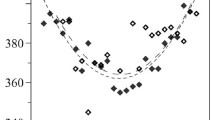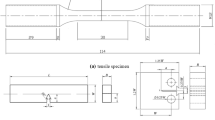Abstract
Ferritic-martensitic steels are considered to be promising candidates for structural materials in fusion technology. However, they are sensitive to irradiation embrittlement, being characterized by a shift of the ductile-to-brittle transition temperature (DBTT) to higher values. It has already been shown in an earlier publication, that dynamic Weibull master curves are useful in estimating the capacity of materials to undergo stable (micro)cracking prior to brittle failure, if Charpy impact tests are performed in the DBTT-range. Thus, experimental dynamic Weibull master curves of three ferritic-martensitic steels, having been obtained by performing series of instrumented Charpy impact tests at a defined temperature in the DBTT-range, have been evaluated for subsize and, in the case of the reference ferritic-martensitic steel of the European Fusion Technology Program MANET II, for normal-size specimens. It has been observed, that the capacities of stable (micro)cracking of MANET II are nearly optimal and clearly superior to those of the other two considered steels. On the other side, the capacity of stable (micro)cracking prior to failure has been found to be highly specimen-size-dependent, nevertheless it is thought to be an important factor in predicting DBTT-shifts due to irradiation embrittlement.
Similar content being viewed by others
References
R. L. Klueh, K. Ehrlich and F. Abe, J. Nucl. Mater. 191 (1992) 116.
N. S. Cannon and D. S. Gelles, ibid. 186 (1991) 68.
K. Krompholz, P. Tipping and G. Ullrich, Z. Werkstofftech. 15 (1984) 199.
M. Lambrigger, part 3 of this series of papers, submitted to J. Mater. Sci.
Idem., part 2 of this series of papers, ibid., to be published.
Idem., part 1 of this series of papers, ibid., to be published.
R. F. Cook and D. R. Clarke, Acta Metall. 36 (1988) 555.
P. Marmy, Plasma Devices and Operations 4 (1996) 211.
M. Victoria, D. Gavillet, P. Spatig, F. Rezaiaria and S. Rossmann, J. Nucl. Mater. 233–237 (1996) 326.
M. Lambrigger, J. Mater. Sci. Lett. 16 (1997) 298.
Idem., Phil. Mag. A77 (1998) 363.
I. Belianov and P. Marmy, to be published in Proceedings of ICFRM-8, October 26–31, 1997 (Sendai, Japan).
Y. Dai, Thèse No. 1388, Ecole Polytechnique Fédéral de Lausanne, 1995.
D. Brook, in “Elementary Engineering Fracture Mechanics” (Martinus Nijhoff Publishers, Dordrecht, 1987) pp. 179–227.
F. M. Beremin, Metall. Trans. A14 (1983) 2277.
W. Weibull, Ingeniörvetenskapakademien, Handlingar No. 151, Stockholm, 1939.
K. Wallin, Eng. Fract. Mech. 19 (1984) 1085.
K. Kendall, N. Mcn. Alford, S. R. Tan and J. D. Birchall, J. Mater. Res. 1 (1986) 120.
G. E. Lucas, H. Yih and G. R. Odette, J. Nucl. Mater. 155–157 (1988) 673.
D. A. Curry and J. F. Knott, Met. Sci. 12 (1978) 511.
S. G. Roberts, M. Ellis and P. B. Hirsch, Mater. Sci. Eng. A164 (1993) 135.
Author information
Authors and Affiliations
Rights and permissions
About this article
Cite this article
Lambrigger, M. Weibull master curves and fracture toughness testing Part IV Dynamic fracture toughness of ferritic-martensitic steels in the DBTT-range. Journal of Materials Science 34, 4457–4468 (1999). https://doi.org/10.1023/A:1004681003889
Issue Date:
DOI: https://doi.org/10.1023/A:1004681003889




